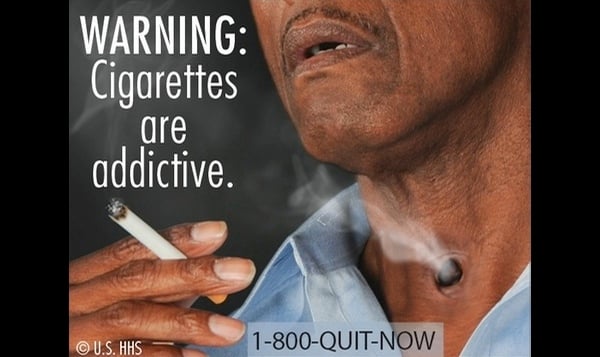Slideshow: The FDA’s Cigarette Warning Labels
The tough-love graphic warning labels on cigarette packages that feature dead or sickly smokers were ruled unconstitutional by US District Judge Richard Leon in Washington yesterday.
The government-mandated labels, which the FDA had planned to distribute on or after September 22, violate the First Amendment by “unconstitutionally compelling speech,” according to Leon’s ruling. Furthermore, Leon said the graphic images are “neither factual nor accurate.”
The FDA chose nine labels that included warnings like “Tobacco smoke can harm your children,” “Cigarettes cause fatal lung disease,” and “Smoking can kill you.” They were paired with graphic images, including a pair of diseased lungs next to a pair of healthy ones, a diseased mouth, and a dead male lying on an autopsy table.
Leon cites the image of the male cadaver that is paired with the text “Smoking kills 443,000 Americans each year.” Said Leon, “The image [. . .] does not provide that factual information.”
Plenty of critics have come forward to denounce the judge’s ruling. In a statement, the president and CEO of the anti-smoking group Legacy, Cheryl G. Healton, said, “The bizarre finding contradicts what we have known for decades—that between one-half and one-third of those who continue to smoke will ultimately die from it.”
Matthew L. Myers of Tobacco-Free Kids called Leon’s ruling “incomprehensible” and argued that smoking is addictive, harms children, causes fatal lung disease, cancer, strokes, and heart disease, and can be fatal. “What isn’t factual or accurate about these warnings? Not even the tobacco industry disputes these facts,” he said in a statement.
However, the plaintiffs in the case, which included five large tobacco companies, argued that the government’s decision to print these labels on 50 percent of each cigarette package would force citizens to do something they were unwilling to do: quit smoking.
“The government may engage in advocacy using its own voice, [but] it may not force others [. . .] to serve as its unwilling mouthpiece,” the plaintiffs wrote in their statement.
Leon agreed with the plaintiffs, stating: “It is clear that the government’s actual purpose is not to inform or educate, but rather to advocate a change in behavior—specifically to encourage smoking cessation and to discourage potential new smokers from starting.”
Tobacco-Free Kids cites 43 other countries that require large, graphic cigarette warnings. Various studies have found that more-graphic depictions on warning labels have produced strong emotional effects among smokers, thus influencing their decision to quit smoking. In fact, Canada introduced similar graphic labels in 2000; a study conducted four years later found that one-fifth of smokers reported smoking less, and about 50 percent said the labels caused them to experience disgust and fear.
The US Department of Health and Human Services released its own statement, saying that the recent ruling will not stop its efforts to warn people about the dangers of smoking, which is the leading cause of preventable death in the United States. “We are confident that efforts to stop these important warnings from going forward will ultimately fail,” the statement read.
The case may move to the Supreme Court, since Leon’s ruling conflicts with that of another US District Court judge, who in January 2010 ruled the labels constitutional.
Read Leon’s ruling here.
What do you think about the graphic labels and Leon’s ruling? Take our poll or leave a comment.



















